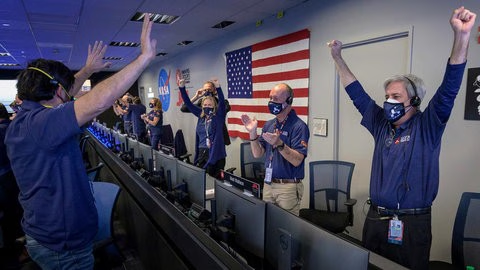“Touchdown Confirmed!”: NASA’s Perseverance Rover Lands on Mars
At 3:55 pm on Thursday, Feb. 18, NASA’s Perseverance rover completed a treacherous landing on Jezero Crater, Mars, bringing us one step closer to determining whether life ever existed on Mars.
The landing process was nerve-wracking; during the “seven minutes of terror,” the Perseverance team could not communicate with the rover because radio signals take 11 minutes to travel between Earth and Mars. When the spaceship finally landed, the NASA control room erupted in applause, as did many millions across the world who were watching along online.
The mission marks a number of firsts: the first helicopter to fly on Mars, the first recording of Martian sounds, and the first attempt to transfer material back to Earth through an interplanetary grab-and-go taking place with a later European rover.
The success of Perseverance’s landing was far from guaranteed: lockdowns threatened an unmovable July launch date, the rover was NASA’s heaviest yet, and it touched down at a site thought too risky for its predecessors.
1. Why do we think there might be life on Mars?
Over the past six decades, everything we’ve learned about Mars suggests it could have once hosted life. (Ironically, actually finding life may be a bad omen for the future of the human race.)
The Curiosity rover, which landed on Gale Crater in 2012, found that Mars once housed water; has methane on its surface; and contains sulfur, nitrogen, oxygen, phosphorus, and carbon. NASA explains these are “key ingredients necessary for life,” and finding them suggests that “ancient Mars had the right chemistry to support living microbes.”
Satellite images also suggest that the red planet had ancient river deltas. Scientists see these areas as promising above-ground candidates for signs of life, theorizing that water could have sustained chemical reactions and even microbes. Perseverance will search one of these deltas with the most powerful tools yet, looking for preserved signs of life in lakebed and shoreline sediments.
2. Is this rover, and NASA more generally, worth it?
Many critics of funding NASA argue that it comes at the expense of solving problems on Earth. However, NASA has a number of benefits that collectively outweigh the opportunity cost:
First, NASA likely saves taxpayers money. The agency has developed more than 2,000 “spin off” innovations, including prosthetic limbs, light-emitting diodes used to treat cancer, and CMOS image sensors. It also provides the technical and logistical support on which other technologies rely; just their contribution to GPS infrastructure could generate benefits of more than double the agency’s budget. UC Irvine Professor Greg Autry thus writes that “every dollar that our nation has spent in space… has been paid back,” often “multi-fold.”
Second, NASA protects against catastrophes. In addition to tracking asteroids that could pose existential risks and researching how to avoid them, it also explores potential future homes for our species. While establishing extraterrestrial civilizations may sound far-fetched, the potential benefits to expanding humanity’s reach and foothold beyond Earth are immense, as philosophers such as Oxford’s Nick Bostrom argue.
Third, NASA provides something more intangible. A sense of shared purpose and hope that’s become increasingly elusive. Insight into huge existential questions. Inspiration for youth to explore STEM. These benefits are less quantifiable, but no less important.
Some NASA skeptics contend that private companies like SpaceX can do the agency’s work more efficiently, saving taxpayer money. However, if anything, their progress may strengthen the case for NASA: these companies have no monetary incentive to freely share their data or discoveries like NASA, and their competitive pressure could catalyze a “public-private space race” improving future NASA missions.
Whether life has existed, or still exists, beyond Earth is one of humanity’s greatest questions. Perseverance brings us just a bit closer to discovering the answer.






